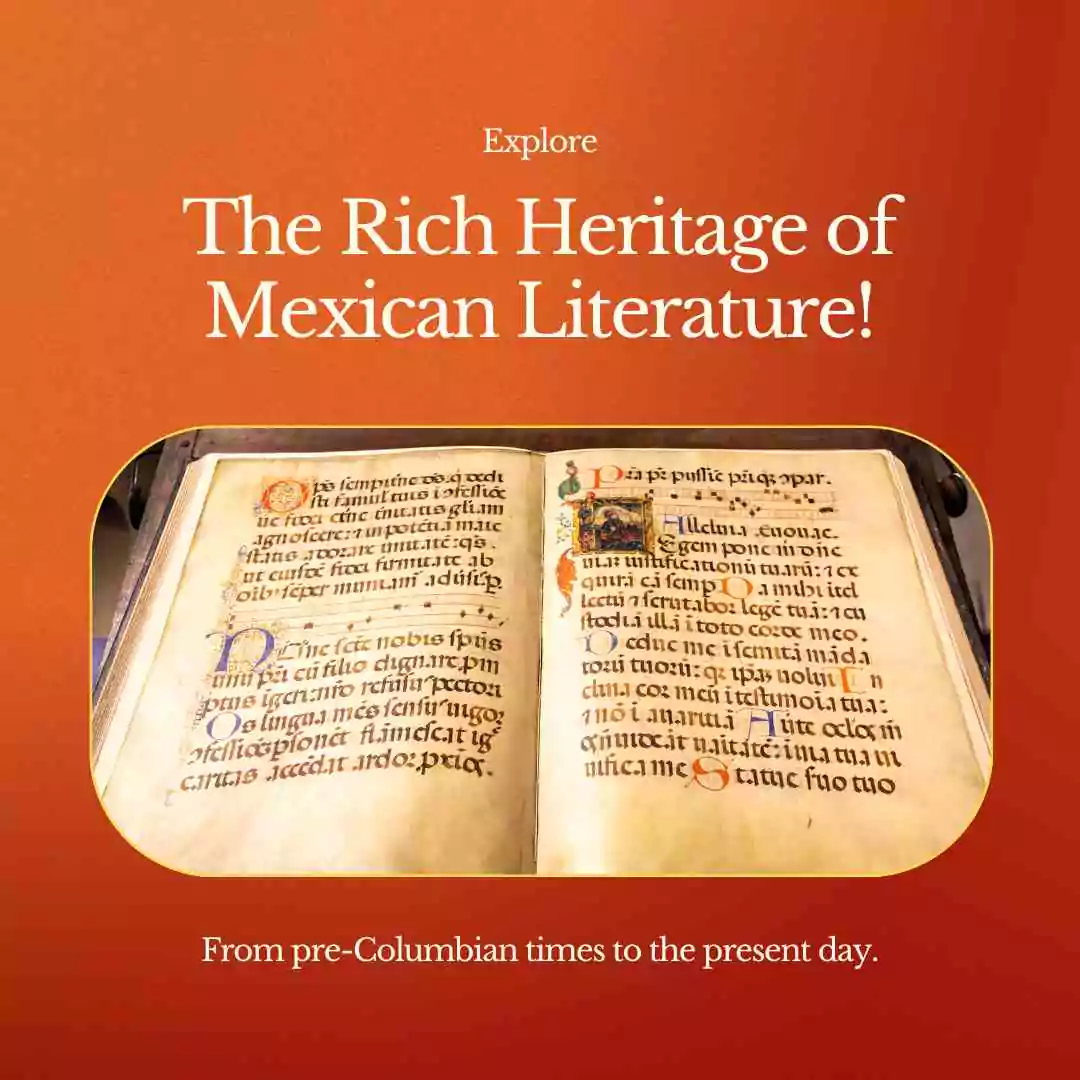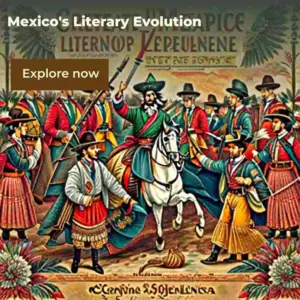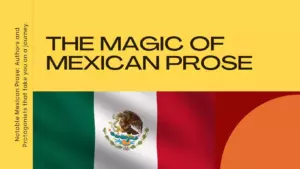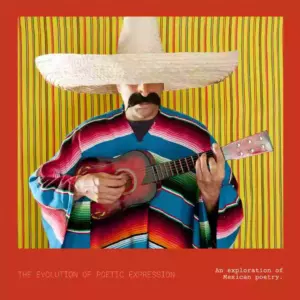
Ever thought about how books can be like time machines? Mexican literature is exactly that a ride through history, culture and tales that echo from ages past. It’s not just about reading, it’s like having a chat with Mexico’s soul. This dive into Mexican literature isn’t just pages and ink, it’s an adventure into a nation’s gutsy journey. So, grab a metaphorical passport because we’re taking a whirlwind tour through the story-packed evolution of Mexican literature. Ready for a literary fiesta? Let’s roll!
The heritage of Mexican literature
In the ancient days, before books got fancy and stories hit the pages, Mexico had this oral thing going on. Picture it like a dope storytelling session, but instead of Instagram, it’s around a campfire with the Olmecs, Toltecs, Aztecs and Mayans dropping poetic wisdom. Epic tales, lyrical vibes – their version of Netflix.
Fast forward to the colonization era, where the script flips. The quill meets the parchment and the stories take a written detour. It’s like your favorite jam suddenly getting remixed, but instead of Spotify, it’s happening on paper. The clash of worlds, a story in itself, as indigenous tales meet the ink of foreign pens. And boom, that’s the start of Mexican literature – a fusion of ancestral wisdom and foreign ink.
Colonial Chronicles and the Clash of Narratives
As Europeans landed on Mexican shores, they brought pens and prejudices. Imagine this: ink meeting resistance, where the stories of the colonized clashed with the colonizers’ biased tales. The Europeans painted indigenous folks as ‘barbaric’ and ‘backward’ talking about seeing the world through tinted glasses.
The clash wasn’t just ink on paper, it was a cultural seismic shift. Indigenous narratives faced off against European languages, a battle where words were both weapons and casualties. The stories told around ancient campfires suddenly had to adapt to the page. Languages collided and the echoes of traditional tales struggled to be heard over the new narrative noise.
Now, imagine this transformation as a crucible. Indigenous voices, once thriving, faced a decline. But guess what? They didn’t just fade away. They adapted, blending their ancient tales with the ‘fancy’ stories brought by the colonizers. It’s like mixing old and new spices to create a whole new flavor indigenous resilience in action.
So, colonial times were tough on narratives. Ink met resistance, but stories persisted, evolving like a resilient species facing a changing environment. This clash wasn’t just a tale of conquest, it was a narrative tug-of-war where every word told a story of survival.

The Unfolding Pages of Independence and Revolution
Ever wondered how a nation’s fight for freedom could echo through its stories? Imagine this: Mexico, early 1800s. The buzz in the air wasn’t just about tacos and tequila, it was a time of grit and rebellion. The struggle for independence kicked off and Mexican writers grabbed their pens like they were swords, fighting with words.
Fast forward to 1821 and Mexico is free! But hold up, the ink didn’t dry on those pages just yet. Now, imagine the Mexican Revolution of 1910 as a literary smackdown. Writers turned into revolutionaries, using their pens as weapons for justice. Themes shifted from just tales of cacti and sombreros to gritty, real stories of everyday heroes.
Genres got a makeover too. We’re not just talking novels, we’re talking social realism, capturing the nitty-gritty of life. Testimonial literature stepped up, giving a mic to the people who lived through the revolution. It was like literature put on a superhero cape, fighting for the little guy.
Think of these chapters in Mexican literature like episodes of a thrilling series. The ink became a mirror, reflecting the highs and lows of a country finding its feet. In short, Mexican writers didn’t just write stories, they wrote history. They made ink the hero of their revolution, leaving a legacy that still echoes through every page of Mexican literature.
Literary Renaissance Amidst Political Turmoil
In the wild whirlwind of the Mexican Revolution, words became warriors. Writers strapped on pens instead of swords, joining the chaos with a literary renaissance. Imagine this: newspapers turned into battlegrounds, ink spilled like blood on pages and stories became bullets of change.
Did you know Don Carlos de Sigüenza y Góngora, a literary trailblazer born in the New World, kicked off this wordy rebellion? His writing was a GPS through the maze of colonial history and indigenous tales.
Now, picture Ángeles Mastretta and Elena Poniatowska as literary superheroes. Mastretta spotlighted fierce females in a country shaking off its revolutionary hangover. Poniatowska? She was the lens on Mexico’s unsung heroes, the poor and women.
These writers? They weren’t just storytellers, they were architects of post-revolutionary Mexico. Their pens built bridges over the rubble, revealing a Mexico grappling with the morning after the revolutionary party.
So, in this literary fiesta, the pen didn’t just write, it roared. It was a paintbrush, a hammer, a compass steering Mexico through uncharted post-revolution waters. It wasn’t merely a revolution, it was an eye-opening revelation. A revelation written with ink, not blood.

Notable Protagonists and Authors of Mexican Prose
Meet the wordsmiths who shaped Mexican prose: Don Carlos de Sigüenza y Góngora, a literary architect who sketched the blueprint of colonial Mexico, Ángeles Mastretta, a journalist extraordinaire, weaving tales of real-life struggles in vibrant hues, and Elena Poniatowska, a storytelling virtuoso, spotlighting the shadows of Mexico’s marginalized.
Sigüenza y Góngora, born and bred in the New World, penned tales that stirred the foundations of colonial Mexico. His words weren’t just ink on paper, they were a revolution, an intellectual uprising.
Mastretta, armed with a pen, championed the unsung heroines of Mexico. In her stories, you’ll find echoes of everyday women navigating a maze of challenges, breaking free from societal shackles.
Poniatowska, the maestro of journalism and storytelling, took a deep dive into Mexico’s underbelly. Her narratives are a mirror reflecting the struggles of the impoverished and the resilience of women.
These authors aren’t just names on book covers, they’re architects of Mexican society. Their words resonate, telling stories that aren’t just written, they’re lived. Dive into their prose and you’ll emerge not just with tales but with a vivid understanding of Mexico’s beating heart.

The Evolution Of Poetic Expression In Mexico
Imagine this: Juana Inés de la Cruz, a rockstar nun from the 1600s, breaking all the rules and dropping knowledge bombs. She wasn’t just praying, she was spitting wisdom in the form of poetry, plays and deep thoughts. Fast forward and we meet Ramón López Velarde, Mexico’s OG poet. His words? Like a painting of Mexico’s soul – raw and beautiful. Then there’s Octavio Paz, a poet-diplomat combo. His verses? Think of them as the soundtrack to Mexico’s journey through tradition and modern chaos.
Back in the day, indigenous folks were into the poetic vibes too. Picture them on stage, doing dramatic, epic and lyric poetry like it’s a ritual – setting the stage for the poetic rollercoaster that is Mexican literature.
Now, let’s jump to today. Elsa Cross and Daniel Sada – modern poets painting Mexico’s complexities with words. Their poetry? It’s like a snapshot of Mexican life, capturing the messy, beautiful, ever-changing scenes.
In this part, we’re not just clapping for individual poets, we’re giving a standing ovation to Mexican poetry itself. It’s not just words on paper, it’s the heartbeat of a nation that echoes through time. Let’s keep the poetic party going! 📜🎉
Echoes of History And Mexico’s Ongoing Literary Landscape
Ready for a literary rollercoaster? Buckle up, because we’re diving into the deep end of Mexico’s literary scene. Imagine history as the DJ, dropping beats that authors can’t help but groove to in their stories. The Mexican Revolution, the fight for independence these aren’t just dusty textbook chapters, they’re the basslines that keep echoing in today’s novels, essays and poems.
You know those novels you pick up and it feels like the author borrowed a time machine? They didn’t. They’re just tapping into the vibes of Mexico’s wild journey. Every page is a piece of a complex puzzle, telling stories of struggle and success that make up the national DNA.
But here’s the thing our journey doesn’t end here. No, no. It’s an open invitation to step into the arena of Mexico’s literary agora. There’s more than ink on paper, it’s a living, breathing conversation between then and now. These stories aren’t locked in the past. They’re vibrant, pulsating threads that weave a tale connecting generations.
So, friend, let’s not just read. Let’s explore. Dive into the narratives that shout from the rooftops, saying, “We’re here and we’re not just words on paper, we’re the beating heart of a nation.” Mexico’s vibrant literary essence calls out to you, inviting you on an adventure that’s yours to seize.
Conclusion
In tracing the remarkable journey of Mexican literature, we uncover not just a chronicle of words but a mirror reflecting the soul of a nation. Each historical milestone imprinted on these pages is a testament to the resilience and spirit of a people navigating the complexities of their cultural evolution. From the vivid oral traditions of indigenous civilizations to the clash of narratives during colonization and the echoes of rebellion in the Mexican Revolution, literature emerges as both witness and chronicler.
As we stand at the crossroads of history and contemporary expression, it’s clear that the inked narratives of the past continue to reverberate in the works of modern Mexican authors.The ongoing relevance of historical narratives in today’s literary landscape serves as a poignant reminder that understanding Mexico’s literature is to comprehend its living history.
Let this exploration not be a mere journey through time but an invitation to delve into the profound connections between Mexico’s turbulent history and the rich tapestry of its literary heritage. Therein lies a wealth of stories waiting to be explored, each page an invitation to understand, appreciate and be inspired by the enduring legacy of Mexican literature.
-Ivan Rangel
- Mar 20, 2024
Native Mexican Animals: Fascinating Wildlife
Fascinating Wildlife of Mexico: Native Mexican AnimalsWelcome to the top notch international of Mexico's natural world! Mexico is a place
- Mar 14, 2024
Safeway Money Order: Best Locations
Find out how easy and safe it's miles to ship cash with Safeway Money Orders. This manual suggests where to
- Mar 08, 2024
The Stock Market Plumbing To
In the complicated world of investing, the stock market plumbing sounds like a strange term. But it is an apt
- Feb 24, 2024
Beyond Finance Legit: Navigating with
Beyond Finance Legit: Unraveling the Legitimacy of Financial Service Providers in Today's Complex Landscape In modern-day complicated monetary panorama, it
- Feb 21, 2024
The Fundamentals of Corporate Finance
Unveiling the Core Tenets: Exploring 'The Fundamentals of Corporate Finance' When we talk about the fundamentals of corporate finance, we're






Past, Present and Future of Mexican Architecture - Ivan Rangel
December 20, 2023[…] The Origin of Mexican Literature […]